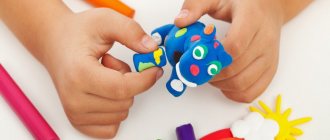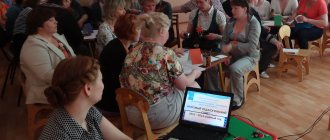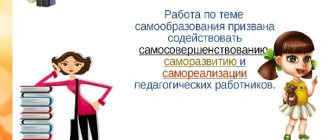Individualization technologies in the educational process of preschool educational institutions
Municipal autonomous preschool educational institution General developmental kindergarten No. 77 in Tomsk
Individualization technologies in the educational process of preschool educational institutions
(pedagogical piggy bank from work experience)
Zharkova M.A.,
teacher speech therapist
MADOU No. 77
Personalization
- this is the development of characteristics that distinguish a person from the surrounding mass.
In the general provisions of the Federal State Educational Standard in paragraph 1.4. — the basic principles aimed at developing the individualization of preschool education are revealed:
-building educational activities based on the individual characteristics of each child, in which the child himself becomes active in choosing the content of his education, becomes a subject of education (hereinafter referred to as individualization of preschool education)
-supporting children's initiative in various activities
- age adequacy of preschool education (compliance of conditions, requirements, methods with age and developmental characteristics).
Teacher's goal:
creating conditions for the individualization of educational relations, ensuring the possibility of social self-determination of the child, independence and initiative.
Teacher's tasks:
- to form in children adequate ideas about the relationships in the “man-environment” system and in the surrounding world itself, based on universal human principles;
-individualization of education for each child;
- to form in the child a value-based attitude towards the world around him, which determines the nature of the goals of interaction with him, motives, readiness to choose certain strategies of behavior from the point of view of moral expediency and his understandings and acceptances;
-to form a system of skills (technologies) and strategies for value-based interaction with the world;
-stimulate creative expression of oneself to the world and knowledge of the world through creative ways of mastering the surrounding reality in specific types of children's activities;
- create conditions for the child to develop independence in planning and implementing his plans;
- timely identify, support and develop children’s abilities and children’s interests;
-formation and development of personality traits in preschoolers, providing the opportunity for the child’s social self-determination, independence and initiative;
- create conditions for the development of independence in planning and implementation of plans;
-develop a teaching staff system for individual child support;
- to develop the activity of a preschooler in various types of children's activities under the conditions of socialization and individualization of children.
Conditions for individualization:
1) ensuring emotional well-being through: direct communication with each child; respectful attitude towards each child, his feelings and needs;
2) supporting the individuality and initiative of children through: creating conditions for the child’s free choice of activities, participants in joint activities; creating conditions for the child to make decisions, express his feelings and thoughts; non-directive assistance to children, support for children's initiative and independence in various types of activities (play, research, design, cognitive, etc.);
3) establishing rules of interaction in different situations: creating conditions for positive, friendly relationships between children, including those belonging to different national, cultural, religious communities and social strata, as well as those who have different (including limited) health capabilities; development of children’s communication abilities, allowing them to resolve conflict situations with peers; developing children’s ability to work in a peer group;
4) construction of variable developmental education, focused on the level of development that is manifested in the child in joint activities with adults and more experienced peers, but is not actualized in his individual activities (hereinafter referred to as the zone of proximal development of each child, through: creating conditions for mastering cultural means of activity ; organization of activities that promote the development of thinking, speech, communication, imagination and children's creativity, personal, physical and artistic-aesthetic development of children; support for children's spontaneous play, its enrichment, provision of play time and space; assessment of children's individual development;
5) interaction with parents (legal representatives) on issues of the child’s education, their direct involvement in educational activities, including through the creation of educational projects together with the family based on identifying needs and supporting the family’s educational initiatives.
The teacher needs to expand the necessary knowledge in children, update their personal experience, create a positive emotional mood, and encourage them to engage in purposeful, useful employment.
Mechanisms for the teacher to organize the individualization of children:
1. Mechanisms (mandatory requirements):
-diagnosis of the child’s abilities and inclinations;
-drawing a trajectory of a child’s success through creating a situation of choice and a situation of success:
• purposeful use of the trial and error method;
• expanding the range of materials and methods of activity;
• taking into account the principles of development of the child as a subject of his own activities (planning techniques);
-algorithms for the sequence of actions:
• creation of pedagogical conditions for the development of strong-willed qualities - the desire to complete a task by a child;
• determination of technology to assist and support the development of a child:
• a) methods; b) funds; c) free and regulated forms of interaction (communication and activity).
2. Specially organized activities in circles,
3. Special educational situations.
4. Free activity of children of a creative and productive nature,
5. Joint cognitive activity of subjects in the “adult-teacher-child” system and the corresponding subsystems “teacher-child (children)”, “teacher-child-parent”, “child-child (children)”.
Results of child individualization:
1. Diagnostics of the trajectory of success
2. Children's portfolio
3. Children's projects
4. Parent-child projects
5. Presentation of children's activity products.
An individual portfolio was presented at preschool educational institution No. 82
child, which is formed for 3 years. Starting from the middle group. The portfolio of each group differs in its content, but the structure is the same for the entire kindergarten: family tree, my surroundings, an individual educational route for 1 academic year, the child’s interests, favorite games, holidays, the happiest day. My horror stories, wishes and dreams for the future, child’s awards (certificates). The portfolio itself is filled out once a week in a group or at home. All pages are offered to children in black and white, the pictures are generalized, and children are invited to color them at their own discretion and desire. In this preschool educational institution, a group portfolio is also maintained, which is filled out by teachers together with the children, the achievements of the entire group.
Individualization of the process in preschool educational institution No. 82 is implemented through success corners.
These corners help to evaluate each child objectively and subjectively, both for the teacher and for the child. Success corners are designed in each group at the discretion of the teachers. The corner itself is a screen with pockets, above each pocket there is a photo or the name of the child. A card lined into 5 parts according to the days of the week is inserted into the pocket. Each color of the week is designated by a specific color. The Success Corner is filled daily in the afternoon. In the middle group, the corner is filled out together with the teacher, and in the senior and preparatory groups, children fill it out independently. The child’s success is assessed by types of activities, which are depicted schematically or in the form of a picture. The child chooses a picture with the activity in which he considers himself successful during the day and sticks the picture on the card. In this way, the teacher can monitor the activities that the child is engaged in and, if necessary, offer other activities so that the child develops comprehensively. At the end of the month, the teacher fills out a summary table, which shows what the child likes and what he was interested in. Recommendations are given to parents on the development of the child.
Thus, the child in the group develops along his own individual path and teachers can easily track the interests and difficulties of the child.
Innovative technologies in training and education
Currently, pedagogy is experiencing a number of crisis phenomena associated with changes in the goals of education, the introduction of state standards and the inclusion of educational technologies in the pedagogical process.
The term “technology” has Latin roots and is translated as “the science of art” (techne - art, skill; logos - word, teaching, knowledge) and denotes a method of guaranteed production of a certain product with predetermined properties.
The most sufficient and broad concept is “pedagogical technology”, which includes the processes of education, training and upbringing. The definition of the concept of “educational technology” is given by many authors:
- A systematic set and order of formation of all personal, instrumental and methodological means used to achieve pedagogical goals (M. V. Klarin);
- a consistent, interdependent system of teacher actions associated with the use of a certain set of pedagogical techniques implemented in the pedagogical process to solve various pedagogical problems (V.A. Slastenin, I.F. Isaev, A.I. Mishchenko, E.N. Shiyanov);
- An ordered system of procedures, the sequential implementation of which will lead to the achievement of a certain planned result. Pedagogical technology is characterized by two points: Ensuring the final result and shaping the future process of teaching and learning (V. A. Monakhov).
S. Trapitsyn (2015) offers a list of classifications of modern pedagogical technologies on various grounds:
- Personal orientation of the pedagogical process: pedagogy of cooperation; humanistic-personal technology Sh.A. Amonashvili; E.N. system Ilyin (literature as a subject that shapes personality);
- Activation and intensification of students' activities: interactive gaming technologies; problem-based learning; technology of communicative teaching of foreign languages E.I. Passova; technology of intensification of learning based on schematic and symbolic models of educational material V.F. Kuznetsova. Shatalov; perspective-transformative learning using reference schemes with annotated control by S. N. Lysenkov; technology of level differentiation; culture-forming technology of differentiated education according to the interests of children I. N. Zakatova; technology of individualization of learning V. D. Shadrikov, A. S. Granitskaya; technology of programmed training; collective training V.K. Dyachenko; group technology; computer (information) technologies;
Didactic improvement and reconstruction of material:
- technology of ecology and dialectics L.V. Tarasova; technology of dialogue of cultures by V. Edinyev; theory of the gradual formation of mental activity by P.M. Erdnieva P. Galperina, M.B. Volovich;
- Technology of early intensive teaching of reading N. A. Zaitseva; Technology for improving general educational skills in elementary school N. A. Zaitsev; Technology of teaching mathematics based on problem solving R. G. Khazankina
- alternative technologies: Waldorf pedagogy by R. Steiner; technology of free labor S. Frenet; probabilistic educational technology A.M. Pubis; workshop technology
- Technologies based on nature: Nature-based literacy according to A. M. Kushnir; technology of self-development according to M. Montessori.
- Technologies of developmental education: technology of developmental education D.B. Elkonina, V.V. Davydova; developmental education system L.V. Zankova; developmental education system focused on the development of creative qualities of the individual I.P. Volkova, G.S. Altshulera, I.P. Ivanova; personality-oriented developmental education I.S. Yakimanskaya, technology of self-developing education G.K. Selevko;





